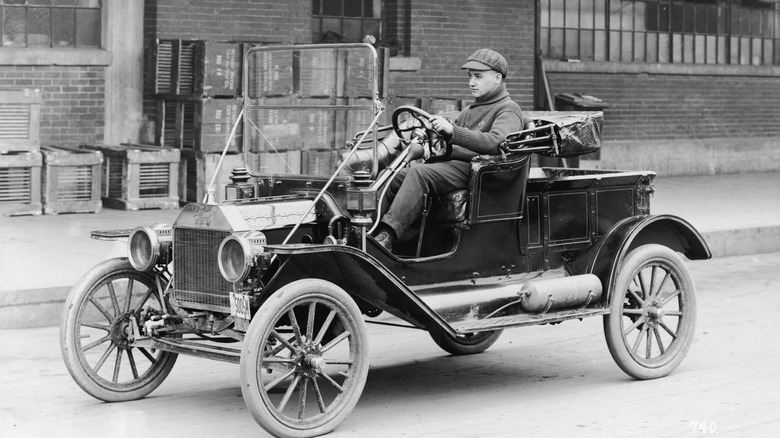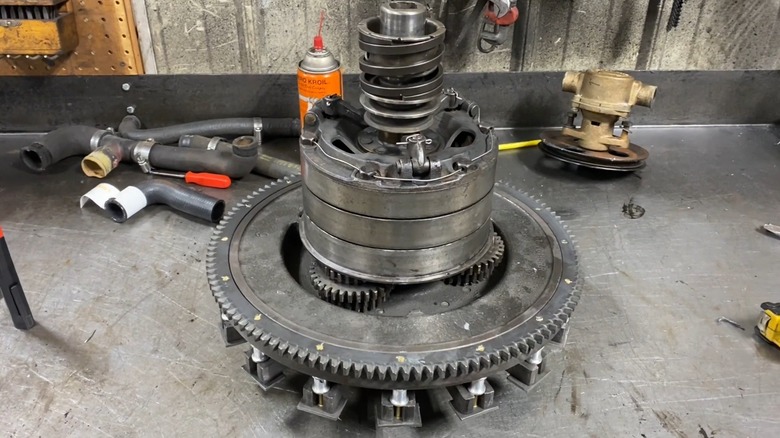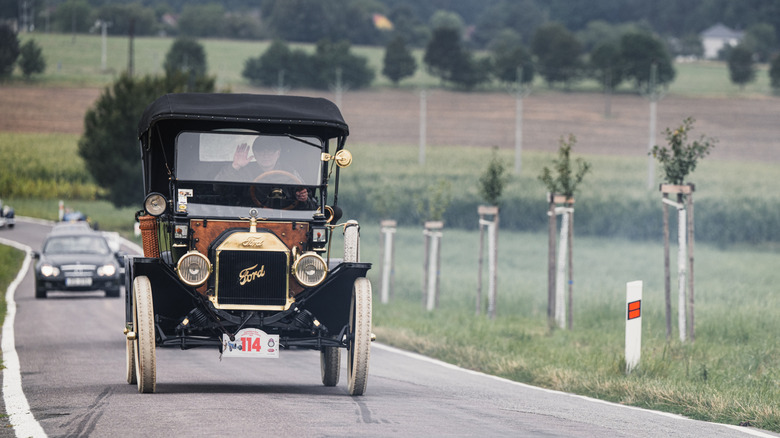What Kind Of Transmission Did The Ford Model T Have?
Pioneering automobiles typically do very little in terms of what we consider "conventional design choices," and the Ford Model T is no exception. Perhaps nowhere is this exemplified more than the layout of its transmission and how to actually drive the thing. Unlike most manual transmissions as we know them today, the Model T's transmission featured a two-speed planetary gearset, providing a basic high and low-gear configuration. So while it was still necessary for a person to actively change gears, the actual layout of those gears was arranged like a modern automatic transmission, with a central sun-gear and planet gears that rotated around it.
The transmission is perhaps the most enigmatic component of the Model T's design, with an internal makeup that looks vastly different from modern designs. Its component diagrams feature items which we'd normally never associate with a transmission, such as brake drums, an internal flywheel, and clutch bands. Looking at a diagram, especially for the less mechanically minded, is often an exercise in pure frustration and futility. It's not surprising that this distinctive and critical element colored the entire Model T's functionality — namely, the transmission dictated its bizarre pedal controls and throttle layout, though it was well-loved for its reliability and durability.
So when Ford commenced production of the Model A, one of its most apparent differences from the Model T was the presence of a conventional three-speed manual transmission, with a shifter and everything, combining the strengths of the Model T's design with an ergonomic layout. Let's explore the origins of its progenitor: the Model T's infamous two-speed, and break down how this eccentric device actually works.
The transmission's components
Let's start with the layout of the gears and how they function. Low-gear utilizes three planetary gears, known as the triple gear. This system rotates on pins with the flywheel, like three spinning planets orbiting the Sun. A single unit of the triple gear itself has three different sets of gear teeth, one of which is for low-gear and two for reverse. The way they engage is through two large bands, each controlled by their own pedals. These bands are meshed with their respective gear teeth and will clamp down on the driveshaft's working components when their pedals are depressed, forcing the driveshaft to rotate at different speeds.
The most important pedal here is the left pedal, which, when depressed, will engage the planetary gears and rotate the driveshaft in low-gear. When the pedal is released, the clutch plates compress and connect the flywheel to the driveshaft. The transmission is effectively bypassed in this configuration, becoming one massive flywheel and rotating at the same RPM as the rear wheels in a direct-drive mode.
This means you have three configurations for the main drive pedal: the first is released, where the clutch is engaged by springs and the car is in direct-drive. The second is neutral, or halfway-depressed, not far enough to disengage the clutch fully to allow the planetary gears to take over. And the third is pressing the pedal all the way down, engaging the planetary gears and forcing the driveshaft to rotate more slowly. The same rule applies to reverse, which is operated on the middle pedal using its own dedicated band and gear teeth. Similarly, the brake utilizes its own unique band.
How everything functions together
Just to reiterate, the transmission is essentially a series of three compressing bands. The pedals operate one band each, and by depressing a pedal, it stops the band by compressing it with its own clutch. When the left pedal's band compresses, it shifts into low-gear or neutral, depending on how far it's depressed. The middle pedal shifts it into reverse by engaging its own ratio in the planetary gearset. And the final band acts as a transmission brake, bringing the whole system to a halt. Because it's all springs and clutches, these pedals operate with some slippage, much like a modern clutch pedal.
This configuration comes with two main inherent downsides. Firstly, when low-gear is engaged, a number of components will move out-of-sync with the input shaft, including all three planetary gears (which is what provides the low ratio in the first place). This leads to excessive noise in low-range, and that's not accounting for the driver having to fully depress the pedal at all times, which can be quite painful on hills. The other downside has to do with the brake pedal – because the band interacts with the driveshaft, when you press on the brake in high-gear, it'll want to stall your engine.
So the correct way to bring a Model T to a stop is to first shift into neutral by pressing the left pedal halfway down, then apply the brakes. Otherwise, the brakes will fight the input shaft and flywheel as well, resulting in poor braking performance because you're trying to stop far more momentum with nothing more than a brake shoe. You use the handbrake once it's stopped, which will shift it into neutral and apply the brake automatically.


